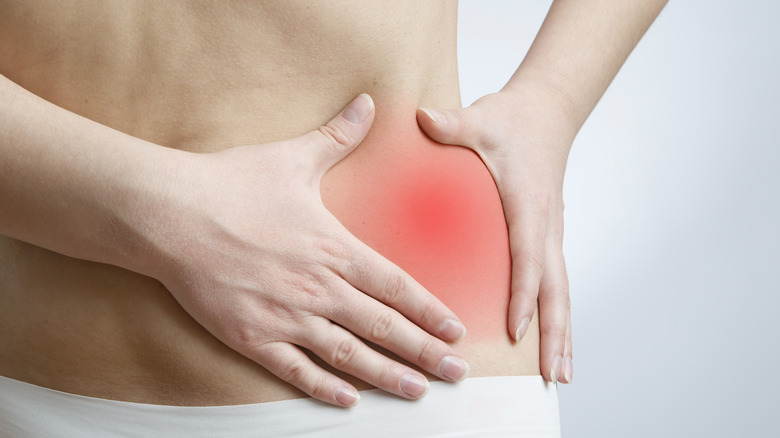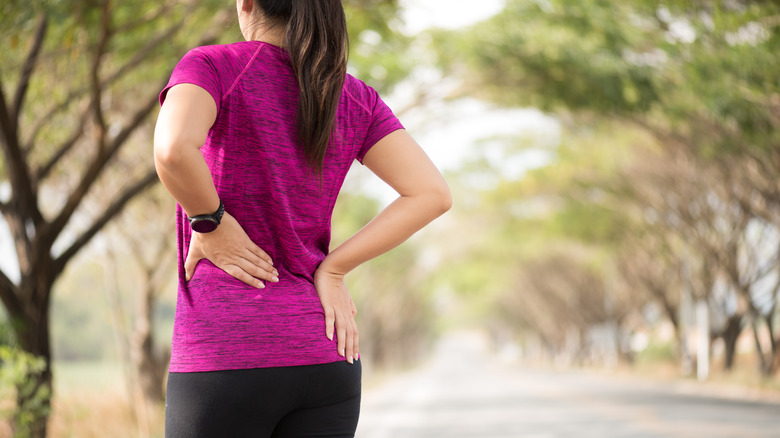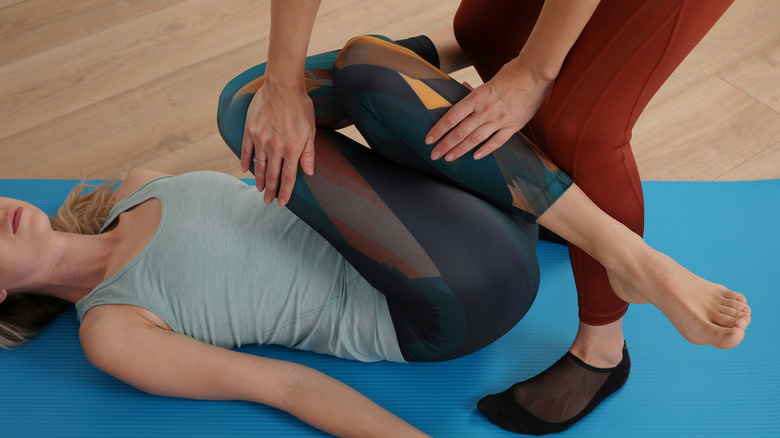What Does It Mean When The Left Hip Hurts?
Left hip pain can affect your ability to stand, walk, exercise, and even sleep. While this issue can be attributed to various conditions, it's not necessarily a reason for concern. Sometimes, your hip pain may be due to over-exercising, previous mild injuries, or inflammation. Your hormones play a role, too. For example, women may experience hip pain before or after their periods. In such cases, the pain is due to dysmenorrhea, a condition characterized by severe menstrual cramps, according to the American Academy of Family Physicians.
The hip joint is surrounded by 21 muscles, including the iliopsoas, gluteus maximus, adductor magnus, and others. These muscles allow you to flex, extend, or rotate your hips, per a 2010 review published in the Journal of Orthopaedic and Sports Physical Therapy. The iliopsoas, for example, contributes to hip and trunk flexion. The hamstrings, on the other hand, allow us to flex our knees and extend the hip. An injury to these muscles may cause pain in either side of the hip and the surrounding tissues.
So, what does it mean when your left hip hurts? Could it be an injury or something more serious, such as arthritis? The answer depends on what other symptoms you're experiencing. Here's what you should know about it.
You might be overusing your hip
Overuse injuries are a common cause of hip pain and may result from muscle imbalances or repetitive movements, according to Temple Health. Piriformis syndrome, for instance, causes pain in the buttocks and hamstrings. You may also feel pain in the back of your hip. Its causes range from vigorous exercise to prolonged sitting, scoliosis, or injuries, according to Harvard Medical School. For example, sitting for long periods can increase pressure on the piriformis muscle and sciatic nerve, causing feelings of tightness. The pain can radiate to the hip and affect your mobility.
Pain in the outer portion of your hip may be a sign of gluteus medius syndrome, says Temple Health. This injury tends to affect people who are new to exercise, but it can also occur in runners and weight lifters. You may also feel a snap in your hip, which occurs when "the hip flexor tendon snaps over the front of the hip as the leg is moved into hip flexion and extension with the knee bent."
Sitting with poor posture may cause hip pain too, warns Healthline. If you normally sit with your leg crossed, you may put additional pressure on your left hip. Over time, this habit can lead to pain, tight muscles, and limited mobility. Pain in the left hip can also be due to arthritis, but this disorder typically has more severe symptoms than an overuse injury does, as noted by Washington University Physicians.
Left hip pain may be due to bursitis
Another common cause of left hip pain is bursitis, or swelling of the bursa. This small, fluid-filled sac acts as a cushion between your bones and soft tissues, per the American Academy of Orthopaedic Surgeons (AAOS). Cycling, running, and other repetitive activities can irritate the bursa, leading to pain and inflammation. The same can happen when you sit for long periods.
This condition has non-specific symptoms, making diagnosis difficult. You may experience sharp pain in the upper hip, especially when walking, squatting, or lying on the affected side. The pain can spread to the outside of your thighs. Other conditions, such as tendinitis, spinal problems, overuse injuries, or muscle tightness have similar symptoms. "Doctors often assume that pain on the outer side of the hip is due to bursitis. But 90% of the time, it's not bursitis," Dr. Lauren Elson told Harvard Medical School.
Luckily, there are steps you can take when experiencing left hip pain. "Pain almost always goes away with targeted exercise and stretching," Elson said. She recommended side or back leg lifts, piriformis stretches, core work, and other exercises that stretch and strengthen the muscles around your hips. A good example is the glute bridge, which strengthens the lower back, hips, and legs. The clamshell, lateral step-ups, and donkey kicks can help, too. You can also do the plank and its variations to build core strength. Ideally, stretch your muscles every few hours, as well as before and after exercise.


